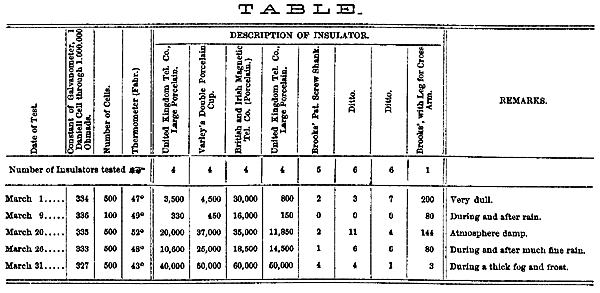[Trade Journal]
Publication: The Telegrapher
New York, NY, United States
vol. IV, no. 42, p. 1, col. 2-3
Relative Resistances of Various Insulators.
THE following table, giving the results of tests of the electrical resistances of different varieties of insulators, were made at the establishment of the India Rubber, Gutta Percha and Telegraph Works Company, Silvertown, London, under the superintendence of MATTHER GRAY, Esq., Engineer and Manager. They will prove interesting, as showing the superiority of the Paraffine Insulator over every other. This result shows that there is no longer any excuse for the wretched insulation of our American telegraphic system, since it has been demonstrated that the most perfect insulator yet produced is the invention of one of our own telegraphers:
 |
The amount given in the table indicate the deflection, per insulator, in degrees, as measured by THOMPSON'S Astatic Galvanometer. The "constant" of the galvanometer is the amount of deflection given by one cell Daniell's Battery through a resistance of 1,000,000 ohms.*
The value of an insulator is, of course, proportionate to the amount of resistances it opposes to the escape of the current. The greater the resistance of the insulators the more perfect this insulation.
The method of finding the relative resistance of the different insulators in ohms is as follows: In the test of March 20, for example, the constant of galvanometer with one cell is 235; with 500 it would be 335 x 500 = 167,500. If 1,000,000 ohms resistance gives 167,500 degrees deflection, the resistance of any insulator may be found by inverse proportion, the less the deflection the greater being the insulation resistance. In the case of the Varley Insulator, for instance, the deflection is 37,000:
37,000: 167,500: 1,000,000: 4,526,027 ohms.
The same day, also, same constant and number of coils for the Brooks' Insulator gives the following ohms:
4: 167,500: 1,000,000: 41,875,000 ohms.
By any inspection of the table it will be seen that in the test of March 31 the best of Brooks' insulator exceeded its rivals forty, fifty, and sixty thousand times in its insulating resistance, and in the test of March 1st the poorest of the Brooks insulators was four times more perfect than the best of the others tested.
* One mile of ordinary telegraph line - 13 ohms nearly.
